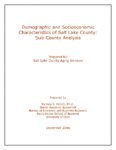TO
| Title | Date | Subject | Description | ||
|---|---|---|---|---|---|
| 151 |
 |
Colorful Gilson did more than promote gilsonite | 1996-03 | The following article from The Times-Independent in Moab pays tribute to the man for whom Gilsonite is named. Utah's American Gilsonite Company traces its roots to Sam Gilson. | |
| 152 |
 |
Combustion emissions and thermal performance impacts when replacing hydrocarbon fuels with hydrogen in industrial furnaces | Many industrial processes rely on heating that is currently achieved through combustion of fossil fuels. The industrial sector generates approximately 23 percent of the greenhouse gas emissions in the US. As infrastructure associated with production and distribution of hydrogen continues to expand, ... | ||
| 153 |
 |
Combustion of municipal solid wastes with oil shale in a circulating fluidized bed | 1996-06-30 | The authors of this report have invented an integrated process for the treatment of municipal solid waste (MSW). In this process, after recycling steps to save usable materials such as aluminum, other metals, and glass have been completed, the resulting refusederived fuel (RDF) is co-combusted with ... | |
| 154 |
 |
Comparing 10 methods for solution verification and linking to model validation | 2005-03-25 | Grid convergence; V&V process; Solution Verification; Discretized continuum; Lawrence Livermore National Laboratory; Computational analyses; Discretization; Continuum process; Finite elemental analyses | Grid convergence is often assumed as a given during computational analyses involving discretization of an assumed continuum process. In practical use of finite difference and finite element analyses, perfect grid convergence is rarely achieved or assured, and this fact must be addressed to make stat... |
| 155 |
 |
Comparison of kinetic analysis of source rocks and kerogen concentrates | 1994-05-10 | Shales and kerogen concentrates from the Green River, Rundel, Ohio, Kimmeridge, and Phosphoria formations were examined by Pyromat II micropyrolysis and kinetic parameters were determined by the shift-in-Tm a x , discrete distribution, modified Friedman, and modified Coats-Redfern methods. Overall, ... | |
| 156 |
 |
Comparison of laboratory and field steamfloods in tar sand | In situ recovery technologies for tar sand and heavy oil are simulated at the Western Research Institute to prepare for pilot tests and commercial operations. Wide ranges of process parameters are tested in one-dimensional reactor tubes in which the tar sand or heavy oil is uniformly reconstituted t... | ||
| 157 |
 |
Comparison of methods for measuring kerogen pyrolysis rates and fitting kinetic parameters | 1987-03-23 | We determine rates of product evolution during pyrolysis of several petroleum source rocks and isolated kerogens by nonisothermal techniques, including Rock Eval pyrolysis and pyrolysis-MS/MS. The resulting data are analyzed by nonlinear regression and simpler correlation techniques in terms of disc... | |
| 158 |
 |
Composition and origin of the Uinta Basin bitumens | 1963-01 | The names of the three formations of interest, from oldest to youngest, the Wasatch, Green River, and Uinta, have been used largely as facies terms to differentiate sediments which were believed to be of different age but actually were deposited simultaneously. The Wasatch is predominantly fluviatil... | |
| 159 |
 |
Computational study of the anode baking industrial furnace | Turbulent flow; Eddy dissipation model; Combustion, NOx; Zeldovich mechanism | In the aluminium industry, the Hall-Héroult process is used for smelting of aluminium using carbon electrodes such as anodes. The baking process of anodes is required for their maximum efficiency during this electrolysis process. The anode baking process contributes up to 15% costs in the aluminium... | |
| 160 |
 |
Concentration of eastern oil shales by froth flotation | 1983 | Concentration of Eastern oil shale has been accomplished by size reduction and froth flotation techniques. The efficiency of kerogen recovery depends on the extent of size reduction (1iberation) as well as frother and promoter additions. Certain grinding aids sucli as sodium silicate and fuel oil ha... | |
| 161 |
 |
Conjunctive surface and groundwater management in Utah: Implications for oil shale and oil sands development | 2011-12-31 | Unconventional fuel development; Conjunctive water use; Surface water; Groundwater; Utah; Utah water law; Oil shale; Oil sands | Unconventional fuel development will require scarce water resources. In an environment characterized by scarcity, and where most water resources are fully allocated, prospective development will require minimizing water use and seeking to use water resources in the most efficient manner. Conjunctive... |
| 162 |
 |
Contemporary projections of Utah's population portend relatively small increases in higher education enrollments | |||
| 163 |
 |
Control strategies for abandoned in situ oil shale retorts | 1979-04 | In situ oil shale retorting may result in a number of environmental impacts including degradation of local surface and groundwaters, low resource recovery and subsidence. The target of present oil shale commercialization activities is the Mahogany zone in Colorado's Piceance Creek Basin. The princip... | |
| 164 |
 |
Conversion of hydrocarbon gases to liquid in the fluidized bed retort | 1987-06-12 | A free radical steady-state mechanism has been developed to explain qualitative and quantitative aspects of the generation of hydrocarbon gases in the solid-recycle fluidized bed retort. The mechanism relies on what is known about butane cracking. The 1- and 2-butyl free radicals have been studied a... | |
| 165 |
 |
Core-based integrated sedimentologic, stratigraphic, and geochemical analysis of the oil shale bearing Green River Formation, Uinta Basin, Utah | 2011-04 | Utah; Green River Formation; Lake Uinta; Mahogany zone; Lake evolution; Oil shale development; Uinta Basin | An integrated detailed sedimentologic, stratigraphic, and geochemical study of Utah's Green River Formation has found that Lake Uinta evolved in three phases 1) a freshwater rising lake phase below the Mahogany zone, 2) an anoxic deep lake phase above the base of the Mahogany zone and 3) a hypersali... |
| 166 |
 |
Coring and testing wells Asphalt Ridge, Utah | 1957-10-21 | A second well was cored and some injection and production tests were made using this well and the well that already existed on Gulf's Palmer lease at Asphalt Ridge, Utah. The formation that has been tested is the Duchesne River, which is more lenticular and erratic than the Mesa Verde which contains... | |
| 167 |
 |
Courses | Courses provided at the University of Utah | ||
| 168 |
 |
Critical issues in Utah's future: volume II | 1977-02 | ||
| 169 |
 |
CRS report for Congress: Developments in oil shale | 2008-11-17 | Green River; Oil shale formation; Colorado; Utah; Wyoming; Oil; Oil shale; Diesel; Jet fuel; Department of Energy; DOE; Synthetic fuels; Petroleum; Energy Policy Act of 2005; EPAct; BLM; Oil research, development, and demonstration; RD&D; Programmatic Environmental Impact Statement; PEIS; Oil shale ... | The Green River oil shale formation in Colorado, Utah, and Wyoming is estimated to hold the equivalent of 1.38 trillion barrels of oil equivalent in place. The shale is generally acknowledged as a rich potential resource; however, it has not generally proved to be economically recoverable. Thus, it ... |
| 170 |
 |
Current activity in oil production from U.S. tar sands | 1979-06-12 | Oil Production; U.S. tar sands; UNITAR; Oil shale; Tar sands; Utah; Oil recovery; Heavy oil; Gas; Hydrocarbon material; Viscous crudes; Oil deposits; Texas; California; New Mexico; Kentucky | In a 1978 paper "Important for the Future" issued by UNITAR, reference was made to a quotation from a study by Resources for the Future, entitled "Energy in the American Economy: 1850-1975," by Messrs. Schurr and Netschert. The quotation is: "Relatively simple calculations of the volume of oil shale... |
| 171 |
 |
Data informed multipoint ground flare evaluation using measurement and theory | This paper will explore the comparison of experimental (PFTIR) and simulation data obtained from assisted multipoint ground flares operating at high turndown. The flare assist is intended to encourage air entrainment for best combustion efficiency as well as reduce visible smoke. Operational envelop... | ||
| 172 |
 |
Decarbonizing: the future of hydrogen firing | Historically, firing hydrogen fuel was only economical in certain applications outside of the power industry. Unlike other fossil fuels, hydrogen does not naturally exist as H2 and is commonly produced in hydrogen reformers and considered an energy carrier and not an energy source. Steam-methane ref... | ||
| 173 |
 |
Definition and world resources of natural bitumens | 1990 | Natural bitumens, semisolid or solid mixtures of hydrocarbons and as much as 50 percent heterocyclic compounds, are composed largely of carbon and hydrogen but have substituents of nitrogen, oxygen, sulfur, and trace metals, especially iron, nickel, and vanadium. Bitumens are soluble in organic solv... | |
| 174 |
 |
Demographic and socioeconomic characteristics of Salt Lake County: sub-county analysis | 2006-12 | Salt Lake County; Projections; Estimates; Aging population; Baby boom; Utah; Salt Lake Aging Services; Kennecott Land | This paper is an examination of the shifting geographic distribution of the population within Salt Lake County over time as well as an analysis of the spatial distribution of its demographic and socioeconomic characteristics. It builds on the county-level analysis included in a separate section of t... |
| 175 |
 |
Demographic patterns and characteristics of Utah | The historical emphasis on numbers rather than on the quality and make-up of the population, though scarcely justifiable, is understandable. Concentration on a single magnitude certainly simplifies the projection of a population. To illustrate, the world population is now approximately 3.5 billion. ... |
